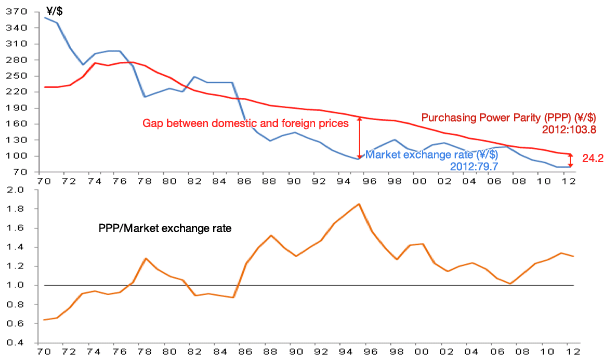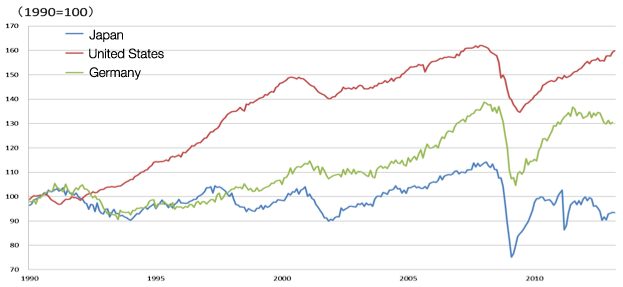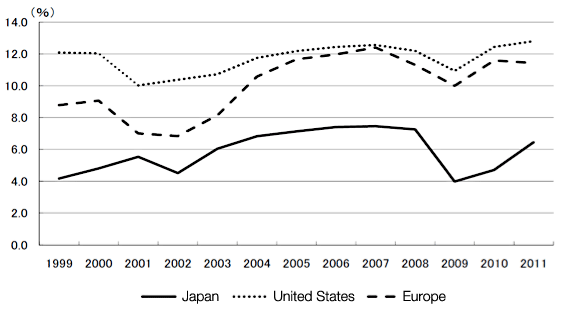Abenomics?an internationally standard policy package aiming at a departure from deflation?has prompted a sharp depreciation of the yen as well as a boost in stock prices since its announcement last autumn with slight corrections.
The effects of Abenomics, especially the depreciation of the yen, are epoch-making and encouraging news for Japan's manufacturing industry whose competitiveness has been impeded by the overvalued yen throughout the "lost two decades." This can be confirmed rather clearly by looking at the continued overvaluation of the yen and the changes in the activity level of Japan's manufacturing industry over the past 20 years. The long-term trends and changes in the yen-U.S. dollar market rates and in the purchasing power parity (PPP) exchange rates in and after the 1970s (Figure 1) and the trends in the index of industrial production (IIP) of Japan, the United States, and Germany from 1990 (Figure 2) demonstrate that the market rates of the yen continued to be higher than their PPP rates, to a significant extent in comparison to other major countries' currencies, since the Plaza Accord until recently, which has exerted a huge deflationary effect on Japan. In line with the appreciation of the yen, the long term trend of Japan's IIP has remained flat, in sharp contrast with the steadily growing indices of the United States and Germany.
Contrasted activity levels of the manufacturing industries in Japan, the United States, and Germany during the "lost two decades" and three turning points
The changes in the IIPs of Japan, the United States, and Germany from 1990 (=100) indicate that, while Japan had not recovered to 100 in March 2013, the United States and Germany recorded approximately 160 and 130 respectively, indicating significant gaps. This process faced three major turning points. The first turning point was in the early 1990s when the trends in stagnant Japan and Germany and the uptrend of the United States diverged. The main causes of Japan's stagnation were the deflationary pressure from the "strong yen syndrome," or the excessive appreciation of the yen due to the market expectation based on the trade friction (see McKinnon, Ohno, and Shirono, 1999), and the consequent increase of overseas investment by Japanese manufacturing companies. In the backdrop of Germany's stagnant IIP were presumably the strong deflationary pressure from such event as fixing the equivalent exchange rate between the former West German and East German marks following the integration of West and East Germany and the socio-economic situation at that time including increasing investment into the former Eastern Europe.


The second turning point is observed around 1998 when the trend in Germany, which had started to rise following the United States, departed from Japan's continuously stagnant trend. At the end of 1998, countries which were planning to join the euro system fixed the exchange rates of their respective currencies to the euro, and in early 1999 introduced the euro as an electronic currency in their respective markets. As a result, before the circulation of the euro paper notes and currency started in early 2002, the exchange risks were eliminated by the introduction of the unified currency, and the low mark rates vis-a-vis other former currencies for trade and capital transactions were fixed. Such events encouraged Germany's manufacturing industry to expand its business in the integrated European Union (EU) market?in sharp contrast with Japan's manufacturing industry whose business environment had worsened due to the severe credit crunch following the concurrent Asian financial crisis and the Yamaichi Securities bankruptcy.
The third turning point is observed around 2003-2004 when Germany's production level started to catch up with that of the United States. In the previous year, 2002, Germany implemented reform of the labor market including the deregulation of layoffs. As a result, German and other EU companies' profit-to-sales ratios reversed their long-term downward trends in the later 2000s. However, that of Japan continued to decline. Japan did not respond effectively to the decrease in existing demand by reducing labor costs or creating new businesses, which resulted in the long-term decline in profit ratios and the stagnant activity level of the manufacturing industry (see Kishimoto, 2008). Germany's manufacturing industry was revitalized presumably owing to the implementation of such reform. While the continued increase of internal reserves in the corporate sector from the 2000s can be interpreted as a hedge against the risk associated with the restrictive financing by main banks, it is also possible to view it as reflective of the lack of new business creation and the stagnating reallocation of resources.

The key is to encourage investment based on "long-term stabilization of exchange rates" and "redevelopment of spatial competitiveness"
For Abenomics to progress effectively toward a departure from deflation and revitalize the Japanese economy, it is essential to stabilize the exchange rates around the current level for the next five years, which was designated as an emergency period for structural reforms. Also, it is extremely important to realize efficient reallocation of resources in response to the changing demand structure in the matured economy, especially in improving the domestic economic environment to reduce fixed costs in areas with decreasing demand and promoting investment in new business areas.
In fact, the governments of many economically-successful countries have implemented certain industrial policies and thereby realized their industrial development and long-term economic growth. Asian countries such as Korea, Singapore, Malaysia, and Thailand as well as other countries such as France, Australia, Finland, and Norway have successfully directed the development of their industries based on protection measures, subsidies, and investment by government-owned companies. Even the United States has helped foster and/or revitalize the computer, semiconductor, aircraft, internet, biotechnology, and other industries, mainly through subsidies for their research and development. There is nothing wrong with governments' proactive involvement itself.
In the real world, however, the desirable shift to a new equilibrium as intended by the government does not necessarily happen smoothly due to asymmetric information and the consequential prisoner's dilemma, and could produce an unintended new deflationary pressure. Naturally, if no new economic activities are created in a matured economy, the higher productivity, based on increased labor mobility and labor participation of women and immigrants, could only lead to higher unemployment. To overcome this paradoxical situation, it is essential to emphasize and clarify the sequence of policy implementations from the expansion of new businesses and investment to the smooth reallocation of resources.
In this sense, what needs to be prioritized, in addition to the stable exchange rates, is to enhance fundamentally Japan's spatial competitiveness for economic activities and to develop earnestly an environment that attracts new business investment in the country. In addition to realizing a business-friendly tax system, regulations, and administrative services, it is necessary to develop user-friendly insolvency laws and financial functions with sufficient and flexible examination capabilities. Redevelopment of a stable energy supply system including the resumption of nuclear power plants is also an indispensable task. Countries, including Germany in 2002, that decisively implemented necessary policies despite their painful programs have succeeded in achieving economic recovery. Japan should robustly implement the right policies to develop spatial conditions so that both foreign and Japanese companies will choose Japan as a "space to conduct manufacturing operations."


